What is it about?
Non-vitamin K antagonists (NOACs) have revolutionized long-term anticoagulation, which is most commonly indicated to prevent strokes in patients with atrial fibrillation. For any form of long-term anticoagulation, the therapeutic benefit of preventing disease and disability has to be balanced against an increased bleeding risk. Both the effectiveness as well as the safety of long-term anticoagulation heavily depends on the patient sticking to the prescribed medication scheme. Vitamin K antagonists (VKA), which were originally marketed as rodenticides have a long standing image problem with a lot of patients and doctors ("rat poison"). NOACs might be accepted more easily due to their superior safety in clinical trials and fixed dose regimes without cumbersome coagulation checks. On the other hand, NOACs might be regarded as "just another pill" and more easily abandoned once the patient feels that he is doing well. Read our publication to find out about the one-year adherence to oral anticoagulation of a cohort of stroke patients with an indication for anticoagulation in the years 2011/2012 when VKA and DOACs were approximately equally used ...
Featured Image
Why is it important?
Our findings show that the adherence to long-term anticoagulation is not significantly influenced by the choice of anticoagulant. We show a strong adherence to the general principle to anticoagulate after a cardioembolic stroke and most patients that switched treatment received an alternative anticoagulant. We presume that the broader choice of anticoagulants available nowadays enforces anticoagulation for stroke prevention.
Perspectives
Another point that I personally find very relevant: In patients who were not (re-) started on anticoagulation before discharge from the stroke units, anticoagulation was reported by far less than 50 % after one year. From my point of view, this highlights the importance of an initiation of anticoagulation by the stroke units or at least a very firm and concrete recommendation.
Dr Waltraud Pfeilschifter
Goethe University Frankfurt
Read the Original
This page is a summary of: Adherence to oral anticoagulant therapy in secondary stroke prevention – impact of the novel oral anticoagulants, Patient Preference and Adherence, November 2015, Dove Medical Press,
DOI: 10.2147/ppa.s88994.
You can read the full text:
Contributors
The following have contributed to this page










